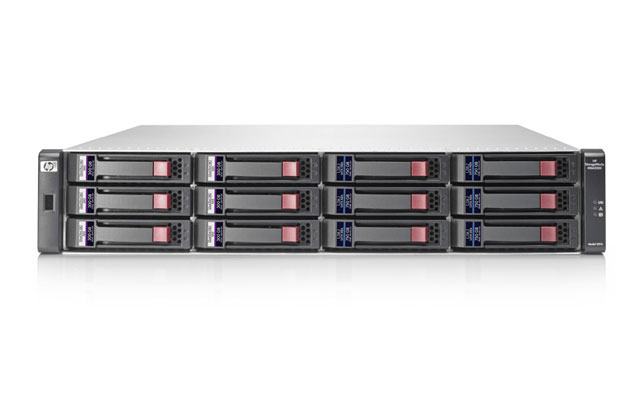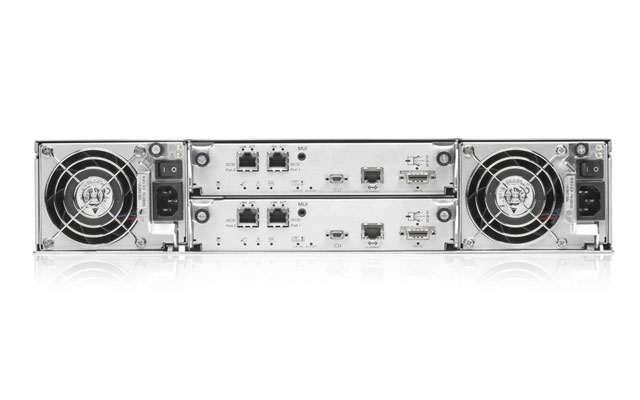EXCLUSIVE - HP StorageWorks 2000 Modular Storage Arrays
Performance under load isn’t great but HP’s new IP and FC SAN appliances look good candidates for SMBs with small pockets.
HP’s latest network storage appliances are competitively priced making them an affordable option for SMBs looking for an FC or iSCSI solution with fault tolerance on tap. Installation is very streamlined and expansion potential looks good but although performance is reasonable our tests do show they won’t cope well with a heavy demand.



For many of the latest SAN solutions a number of storage vendors have decided to combine both FC and IP capabilities in the same unit. HP's latest StorageWorks products take the opposite tack as the new 2000 Modular Storage Arrays (MSAs) are offered with either fibre channel or iSCSI RAID controllers. The twelve bay disk cabinets are the same you just choose which SAN you want to go with.
These are aimed squarely at SMBs with limited budgets and a glance at the price tags shows that HP looks to have hit the mark for value although the prices we've listed don't include any hard disks. We take an exclusive look at both products as on review we have the 2012i and 2212fc arrays.
The 2U chassis accepts high performance SAS and high-capacity SATA drives and you can mix and match them in the same chassis as required. There's plenty of fault tolerance on tap as the chassis supports two RAID controllers along with dual combined fan and power supply units.
HP offers a range of controller options with base FC and iSCSI models coming with a single controller. A pair of standard controllers provides active-active failover, whilst the enhanced model such as the 2212fc on review has two controllers and a faster processor. Expansion options look good as the single SAS port on the RAID controllers supports up to three disk shelves enaqbling capacity to be boosted to a theoretical maximum of 36TB using SATA drives.
Instead of using a battery backup pack to protect the cache contents the RAID controllers use a combination of a 512MB CompactFlash card and capacitor. If there's a power failure the cache contents are written to the card and the main advantage here is the capacitor takes far less time to charge than a battery and can provide full protection much quicker. The two controllers are also joined with a high-speed, direct link. Data written to one controller is synchronously mirrored to the other with the aim of improving general performance by reducing internal system traffic between the controllers.
We kicked off with the iSCSI array and had no problems with basic installation as you simply point a web browser at the controller's dedicated management port. The tidy web interface opens with a basic status display for the array cabinet, virtual disks and controllers with options to drill down to individual components. The enclosure view shows which bays in the array and any attached expansion units have drives in and hovering the pointer over them reveals the drive type and model lurking inside.
We began by creating virtual disks, or vdisks, where you select physical drives, pick from a choice selection of RAID array types and assign hot-spares. Some on-line array expansion options are provided, as although you can't migrate from one RAID type to another it is possible to add more drives to existing arrays and expand into them although this doesn't include mirrors.
Sign up today and you will receive a free copy of our Future Focus 2025 report - the leading guidance on AI, cybersecurity and other IT challenges as per 700+ senior executives
Dave is an IT consultant and freelance journalist specialising in hands-on reviews of computer networking products covering all market sectors from small businesses to enterprises. Founder of Binary Testing Ltd – the UK’s premier independent network testing laboratory - Dave has over 45 years of experience in the IT industry.
Dave has produced many thousands of in-depth business networking product reviews from his lab which have been reproduced globally. Writing for ITPro and its sister title, PC Pro, he covers all areas of business IT infrastructure, including servers, storage, network security, data protection, cloud, infrastructure and services.
-
 Google DeepMind CEO Demis Hassabis thinks this one area of the tech industry is probably in an AI bubble
Google DeepMind CEO Demis Hassabis thinks this one area of the tech industry is probably in an AI bubbleNews AI startups raising huge rounds fresh out the traps are a cause for concern, according to Hassabis
By Ross Kelly Published
-
 Everything you need to know about Google and Apple’s emergency zero-day patches
Everything you need to know about Google and Apple’s emergency zero-day patchesNews A serious zero-day bug was spotted in Chrome systems that impacts Apple users too, forcing both companies to issue emergency patches
By Nicole Kobie Published
-
 Ronald Richardson to lead Leaseweb’s global commercial strategy
Ronald Richardson to lead Leaseweb’s global commercial strategyNews The experienced executive has been named Leaseweb’s new CRO as the IaaS provider embarks on the next phase of its growth journey
By Daniel Todd Published
